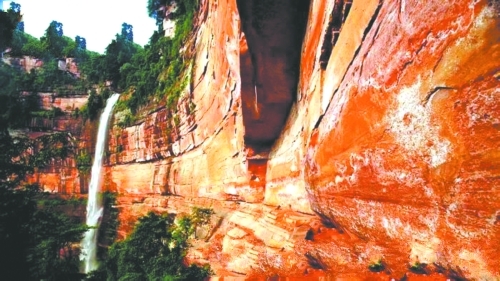Shatan School
Shatan Village, located in Xinzhou Town of Zunyi City, is 47 kilometers from the modern downtown area. The village takes its name from a shoal on the Le’an River, though colloquially it is referred to as Qinzhou, as it is laid out in a way that supposedly resembles the qin, an ancient Chinese string instrument. The greater Shatan area contains waterways, farmers’ fields, bamboo forests, thousand-year-old cypress trees and a number of ancient temples. The natural bounty has produced many a man of note in Chinese history, including Zheng Zhen, Mo Youzhi and Li Shuchang. The combined cultural influence of these men of letters is referred to as the Shatan School.
Guizhou province is a land of culture, and Shatan especially so. The Shatan School finds its genesis in the Eastern Han Dynasty (25-220) with the noted educator and calligrapher Yin Zhen. With his follower (some say equal) Li Xun, Yin Zhen championed local culture and regional-based philosophy.
Entering our era, Zhang Shizhao kept the Shatan School of philosophical thinking alive. Zhang in his writing was keen to stress the continuity of the school, and champions the legacies of the aforementioned Zheng Zhen and Mo Youzhi, who co-wrote Annals of Zunyi Prefecture, a document highly praised for its acuity by Liang Qichao, a renowned reformist and philosopher of the late Qing Dynasty. The work has since been favorably compared with many of China’s great histories.
Mo Youzhi is depicted in the annals as a well-read man of high moral integrity. He is said to have refused high posts in the royal court in order to continue with his studies. Zeng Guofan, a high-ranking official at the time, attended Mo’s funeral and penned an elegant couplet in his honor.
In the modern area, Li Shuchang is perhaps Shatan’s most notable alumnus. He was the first Guizhou native to serve in China’s diplomatic corps overseas, and served as a counselor to Chinese embassies in Europe. He interacted extensively with officials from the U.K., France, Germany, Spain, Belgium, Italy, Austria and Sweden, and wrote a book about his experiences. His efforts have brought the European and Chinese peoples closer together.
 |
|
The red rock landform in Chishui.
|
Chishui Waterfall
Shatan doesn’t have a monopoly on Zunyi’s natural spectacle. Mountains, rivers, hot springs and caves are dotted throughout the city’s broad territory. One site, Danxia, is listed by UNESCO as a world heritage site. “Danxia” is the name given to local landscapes developed on continental red terrigenous sedimentary beds influenced by endogenous forces (including uplift) and exogenous forces (including weathering and erosion). The scientific explanation doesn’t do the area justice – Danxia scenery is truly awe-inspiring.
Zunyi’s potential for nature tourism, yet to be tapped, deserves to be mentioned alongside well-worn sites like the Three Gorges and Jiuzhaigou. Among Zunyi’s sites definitely worth a visit are the Chishui Waterfall, the Chahai tea-growing region, the river valleys of Wujiang, Kuankuoshui and Dashahe, the lake area of Qingxi, Phoenix Mountain, Bamboo Sea and a number of national and provincial forest parks. Danxia should be on every nature tourist’s list. Another highlight is the Shuanghe karst cave, formed naturally over millions of years by the dissolution of soluble bedrock.
The Chishui Waterfall, also known as Shizhangdong, is located 39 kilometers from Chishui City on the middle reaches of the Fengxi River. Alongside Huangguoshu, it is one of Guizhou’s two most famous waterfalls. Measuring 76 meters in vertical distance and 80 meters wide, the Chuishui Waterfall is eight meters taller than Huangguoshu’s, and one meter narrower.
We recommend:
